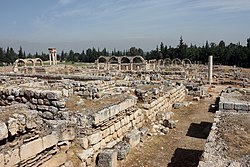al-Abbas ibn al-Walid
| al-Abbas ibn al-Walid العباس بن الوليد | |||||
|---|---|---|---|---|---|
| Died | 750 Harran | ||||
| |||||
| Dynasty | Umayyad | ||||
| Father | al-Walid I | ||||
| Religion | Islam | ||||
| Military career | |||||
| Allegiance | Umayyad Caliphate | ||||
| Service/ | Umayyad army | ||||
| Years of service | c. 707–720s | ||||
| Rank | Army General | ||||
| Battles/wars | Arab–Byzantine wars | ||||
| Relations | Sulayman (uncle) Yazid II (uncle) Hisham (uncle) Maslama (uncle) | ||||
al-ʿAbbās ibn al-Walīd ibn ʿAbd al-Malik was an
His fortunes declined under his father's successors, except for a relatively brief revival under
Origins
Abbas was the eldest son of the
Expeditions against the Byzantines
He first appears in the 707 campaign against the important Byzantine fortress of Tyana in Cappadocia, where he led the Arab army alongside his uncle Maslama ibn Abd al-Malik. The town withstood a long siege over the winter of 707–708, and surrendered only after a Byzantine relief army was defeated in spring. During the latter battle, Abbas is said by Arab chroniclers to have distinguished himself for the crucial role he played in stopping the wavering Arabs from fleeing and driving them on to victory.[5][6]
Abbas participated regularly in the almost annual expeditions launched into Byzantine
Relations with the caliphs
Besides his command roles in the Byzantine wars, Abbas was appointed by his father as governor of the
Abbas regained favor under his uncle Caliph Yazid II (r. 720–724), who reinstated him as a top commander on the Byzantine front and also as the co-leader of the Umayyad army which suppressed the major revolt of Yazid ibn al-Muhallab in Iraq in 720; the other lead commander was Maslama.[10][5]
His renewed fortune was relatively short-lived, as he once again became sidelined by a new caliph, this time Yazid II's successor, Abbas's uncle
By the time of Hisham's death in 743, Abbas was likely "the most senior figure in the wider Marwānid family", according to the scholar Leone Pecorini Goodall. One report quoted by the 9th-century historian al-Tabari calls him sayyid Bani Marwan ('leader of the Marwanids').[14] As a son of a slave woman, rather than a free Arab of noble lineage, Abbas, like Maslama, had never been considered for the caliphal succession.[15] Despite his dismissal as its governor, Abbas had continued to reside in the city of Homs, where he commanded the loyalty of at least part of the district's troops.[16]
Founding of Anjar

While the establishment of the madina ("city") of
Role in the Third Fitna
During the reign of his cousin, the unpopular al-Walid II (r. 743–744), Abbas was initially reluctant to oppose the caliph and counselled against provoking a civil war. In the end, however, he participated in the conspiracy and coup that deposed Walid and brought Abbas's brother Yazid III on the throne.[5] Neither Yazid nor his successor Ibrahim lasted long on the throne, which fell to the general Marwan ibn Muhammad (r. 744–750) during the ensuing civil war of the Third Fitna. Marwan had Abbas thrown into prison in Harran, where he died of a disease in 750.[5][6]
Descendants
Al-Abbas was held by the 10th-century historian
References
- ^ Marsham 2022, p. 38.
- ^ Goodall 2022, p. 392.
- ^ Fowden 2004, p. 241.
- ^ Goodall 2022, pp. 391–393.
- ^ a b c d e f Zetterstéen & Gabrieli 1960, pp. 12–13
- ^ a b c Lilie et al. 1999, p. 4
- ^ Blankinship 1994, p. 119
- ^ Crone 1980, p. 126.
- ^ Goodall 2022, pp. 388–390.
- ^ Goodall 2022, pp. 388, 391.
- ^ Goodall 2022, p. 391.
- ^ Goodall 2022, p. 394.
- ^ Goodall 2022, p. 393.
- ^ Goodall 2022, p. 402.
- ^ Goodall 2022, p. 387.
- ^ Goodall 2022, pp. 395, 404, 411–412.
- ^ Bacharach 1996, pp. 34–35.
- ^ Scales 1994, p. 114.
- ^ Goodall 2022, p. 397.
- ^ Uzquiza Bartolomé 1994, p. 458.
Sources
- ISBN 90-04-10633-2.
- ISBN 978-0-7914-1827-7.
- ISBN 0-521-52940-9.
- Goodall, Leone Pecorini (2022). ""The ʿAbbās after Whom Those Who Rule in Baghdad Are Named": Al-ʿAbbās b. al-Walīd in Late Antique Accounts of the Marwānids and the Third Fitna". Al-Usur al-wusta: The Journal of Middle East Medievalists. 30. Columbia University: 384–434. .
- ISBN 0-520-23665-3.
- ISBN 978-3-11-015179-4.
- Marsham, Andrew (2022). "Kinship, Dynasty, and the Umayyads". The Historian of Islam at Work: Essays in Honor of Hugh N. Kennedy. Leiden: Brill. pp. 12–45. ISBN 978-90-04-52523-8.
- Scales, Peter C. (1994). The Fall of the Caliphate of Cordoba: Berbers and Arabs in Conflict. Leiden: E. J. Brill. ISBN 90-04-09868-2.
- Uzquiza Bartolomé, Aránzazu (1994). "Otros Linajes Omeyas en al-Andalus". In Marín, Manuela (ed.). Estudios onomástico-biográficos de Al-Andalus: V (in Spanish). Madrid: Consejo Superior de Investigaciones Científicas. pp. 445–462. ISBN 84-00-07415-7.
- Zetterstéen, K. V. & Gabrieli, F. (1960). "al-'Abbās b. al-Walīd". In OCLC 495469456.
